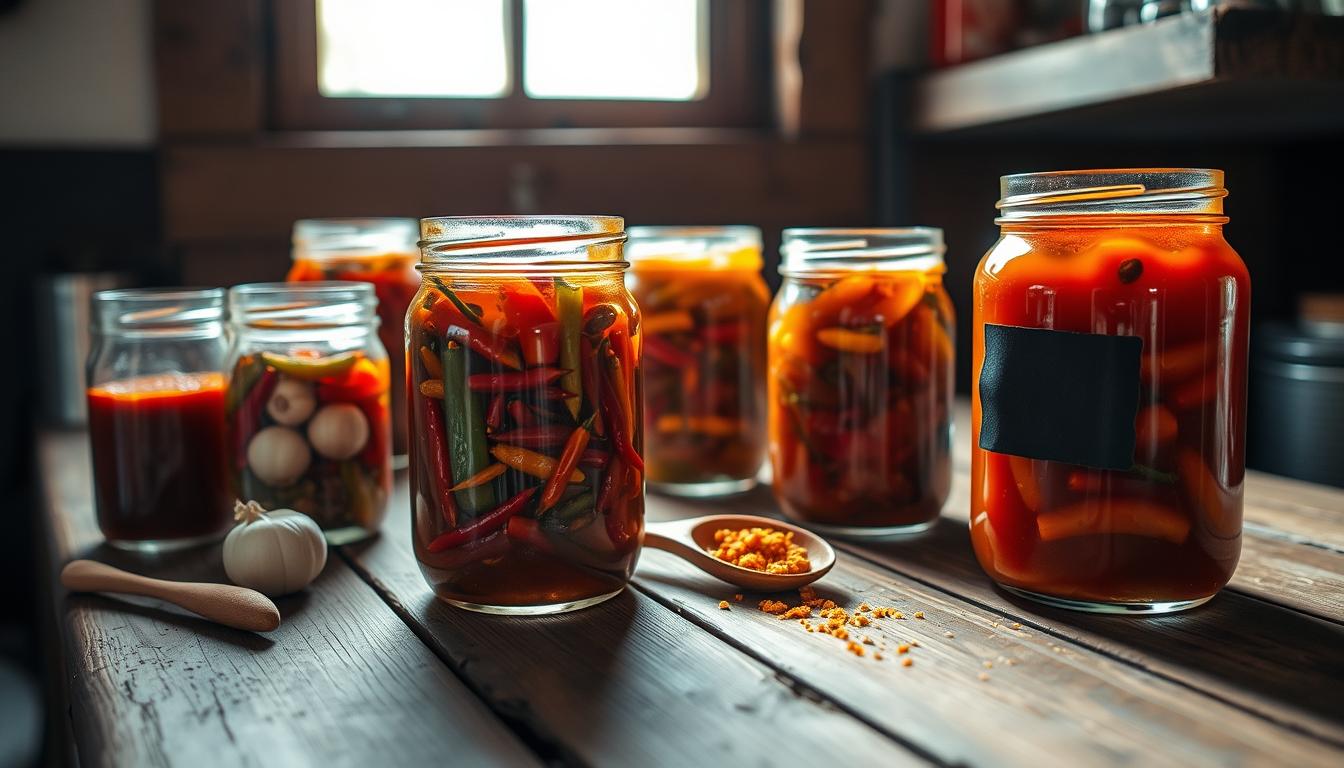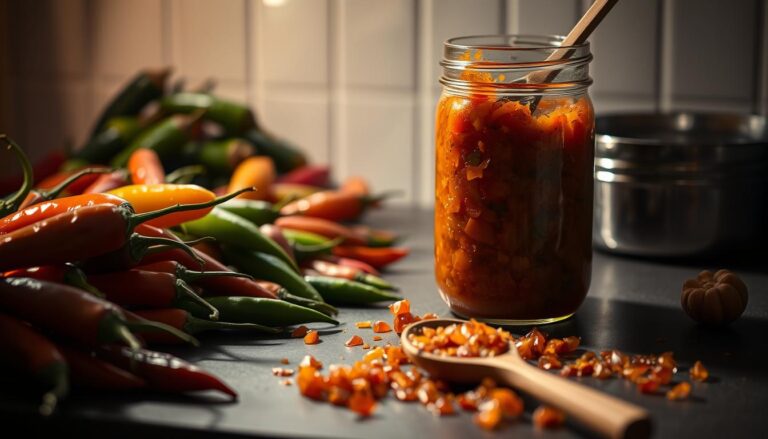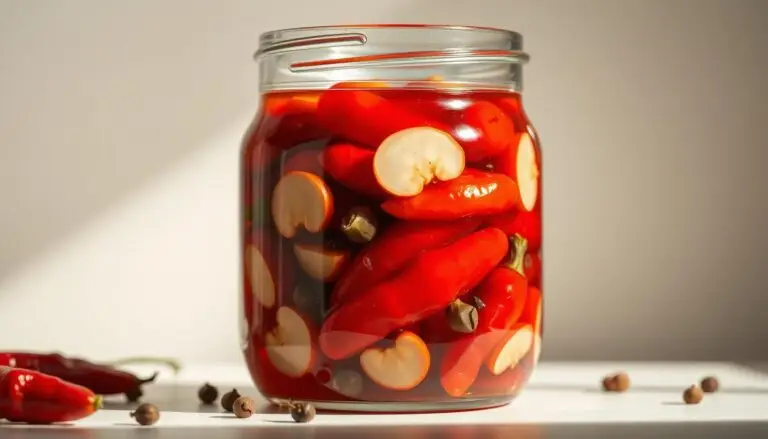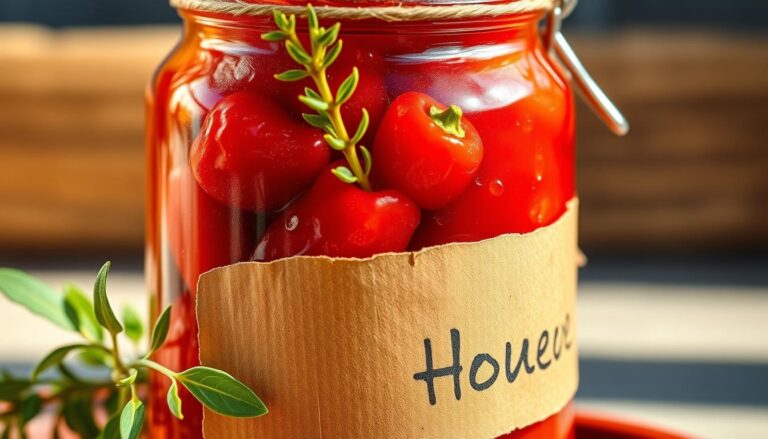How to Make Fermented Hot Pepper Sauce: A Step-by-Step Guide
Table of Contents
Making your own fermented hot pepper sauce is a fun journey. It turns simple ingredients into a tangy, complex condiment. This homemade hot sauce blends old fermentation methods with new flavors, making a unique and tasty condiment.
Fermented hot pepper sauce has a rich, deep flavor that store-bought sauces can’t match. Using lacto-fermentation, you’ll get a sauce full of probiotics and depth. Don’t worry, with the right help, you’ll soon make top-notch homemade hot sauce.
You’ll end up with about 1 quart of sauce, full of vibrant flavors and healthy probiotics. This guide will help you pick the best peppers and master fermentation. You’ll learn to make an amazing fermented hot pepper sauce that will wow hot sauce fans.
Whether you love spicy foods or are new to fermentation, this recipe is for you. Get set to turn 18 ounces of hot peppers and a few simple ingredients into a culinary masterpiece. It will make your meals better and show off your kitchen skills.
Understanding Fermented Hot Pepper Sauce
Making artisanal pepper sauce is more than just following a recipe. It’s about turning simple hot peppers into a complex, probiotic-rich sauce. This sauce is loved by food lovers and health buffs alike.
The Science Behind Fermentation
Fermentation is a cool process that turns fresh peppers into a tangy, flavorful sauce. Good bacteria break down sugars in the peppers. This creates unique tastes and health benefits.
- Initial pH typically starts around 6.5
- Bacterial cultures develop within 1-3 days
- pH drops to approximately 4.0 by day 10
- Final pH stabilizes between 3.4-3.8
Benefits of Lacto-Fermentation
Lacto-fermentation brings big benefits to your pepper sauce. It not only makes the sauce taste better but also boosts its nutritional value. Here’s how:
- It produces good probiotics
- It keeps important antioxidants
- It creates complex flavors
- It makes the sauce easier to digest
Traditional vs Modern Methods
Old ways of fermenting have merged with new cooking styles. Ancient methods used salt and time. Today, we use precise temperature control and know how microbes work together.
Your homemade probiotic hot sauce is a mix of old wisdom and new techniques. It’s tasty and good for you.
Essential Equipment and Tools
Making a top-notch organic hot pepper condiment needs the right tools. Start by picking high-quality, food-grade materials. These ensure your safety and help bring out the best flavors.
Here are the key tools for making your homemade organic hot pepper condiment:
- Wide-mouth Mason jars or ceramic crocks are perfect for fermentation
- Fermentation Weights: Ceramic or glass weights keep peppers under water during fermentation
- Airlock Lids: Special lids let gases out but keep contaminants away
- pH Meter: Important for checking fermentation and keeping food safe
- High-Powered Blender: Needed for a smooth, even sauce texture
- Storage Bottles: Clean, sterilized glass bottles for keeping your condiment fresh
Keeping things clean is key when making your organic hot pepper condiment. Use Star San sanitizer. It works fast, needing only 30 seconds to sterilize your gear without rinsing.
“The right tools transform good ingredients into extraordinary flavors” – Fermentation Experts
Choose quality equipment for consistent fermentation. This will help you make a top-notch organic hot pepper condiment. It will impress with its flavor and quality.
Selecting the Right Peppers
Creating the perfect spicy condiment starts with choosing the right peppers. The flavor and heat of your fermented chili sauce depend on the peppers you pick. Knowing about pepper characteristics helps you make a sauce that tastes just right to you.
Hot Pepper Varieties Guide
Different peppers have unique flavors and heat levels. Here are some popular choices for your fermented chili sauce:
- Mild Peppers: Bell peppers (0-500 SHU) for sweetness
- Medium Heat: Fresno chiles (2,500-8,000 SHU) with balanced flavor
- Hot Peppers: Cayenne (30,000-100,000 SHU) for a big kick
- Super Hot: Habaneros (100,000-350,000 SHU) for intense heat
Combining Peppers for Optimal Flavor
Mixing different peppers can make your spicy condiment more complex and interesting. Using both mild and hot peppers lets you control the heat. It also adds depth to your fermented chili sauce.
Heat Level Considerations
Think about how spicy you like things when picking peppers. Start with milder ones and add hotter ones later. The Scoville Heat Unit (SHU) scale helps you understand and manage the spiciness of your sauce.
Pro Tip: Always wear gloves when handling hot peppers to protect your skin from capsaicin!
Preparing Your Fermentation Brine
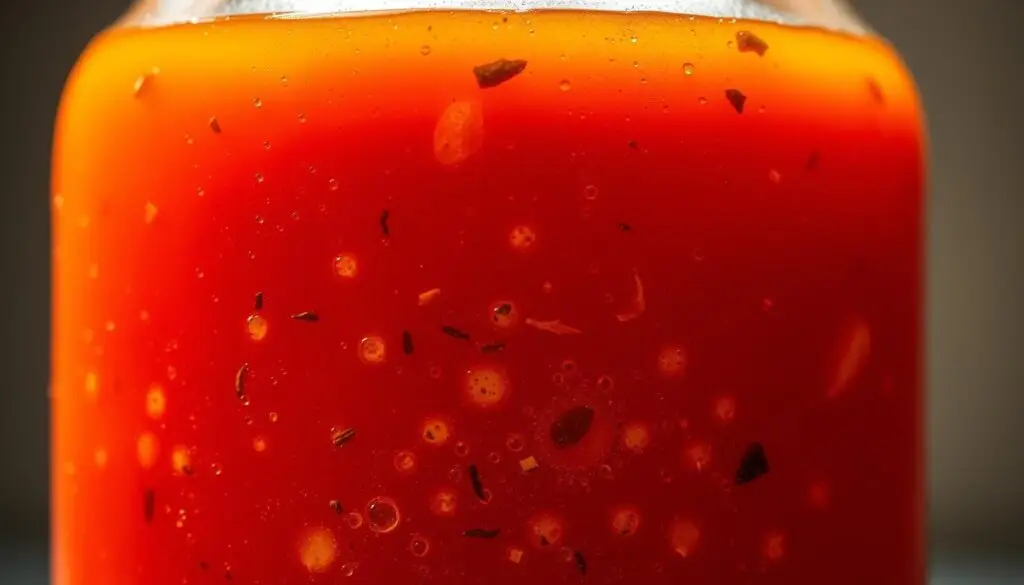
Making the perfect brine is key for a tangy hot sauce. It gives your sauce rich flavor and ensures safe fermentation. Your brine turns fresh peppers into a tasty fermented condiment.
For a great tangy hot sauce brine, focus on water quality and salt amount. Use filtered or non-chlorinated water for the best fermentation. Tap water can have chemicals that harm the process.
Brine Composition Essentials
- Salt concentration: 2-3% by total weight
- Water type: Filtered or non-chlorinated
- Temperature range: 68-72°F (20-22°C)
For your brine, use a precise salt-to-water ratio. For every liter of water, add about 25 grams of salt. This ratio creates a perfect environment for good bacteria and stops bad ones.
Brine Preparation Steps
- Measure water precisely
- Add measured salt
- Stir until completely dissolved
- Allow brine to cool to room temperature
The fermentation process turns your brine into a complex, tangy hot sauce. Lactobacillus bacteria grow, adding unique flavors and preserving it naturally. Your careful brine preparation is the start of a fantastic homemade condiment.
Safety Measures and Handling Hot Peppers
Making homemade hot sauce needs careful safety steps. Handling hot peppers requires special care to avoid irritation and ensure a good cooking process.
Protective Equipment Needed
When making your hot sauce, wearing the right gear is key. Experts say to use:
- At least two layers of latex or nitrile gloves
- Safety glasses to protect your eyes
- Long-sleeved clothing
- An apron to keep your clothes safe
Proper Ventilation Requirements
Capsaicin, the heat in peppers, can make strong fumes. To avoid this, make sure to:
- Work in a well-ventilated kitchen
- Open windows while making hot sauce
- Use a range hood or exhaust fan
- Avoid being near pepper vapors for too long
Emergency Care Tips
If you accidentally get capsaicin on you, act fast:
| Exposure Area | Recommended Treatment |
|---|---|
| Skin Irritation | Wash with milk or soap and cool water |
| Eye Contact | Flush with cool water for 15 minutes |
| Respiratory Irritation | Move to fresh air, drink water |
“Safety first when crafting your homemade hot sauce – protect yourself to enjoy the spicy journey!”
Making Fermented Hot Pepper Sauce
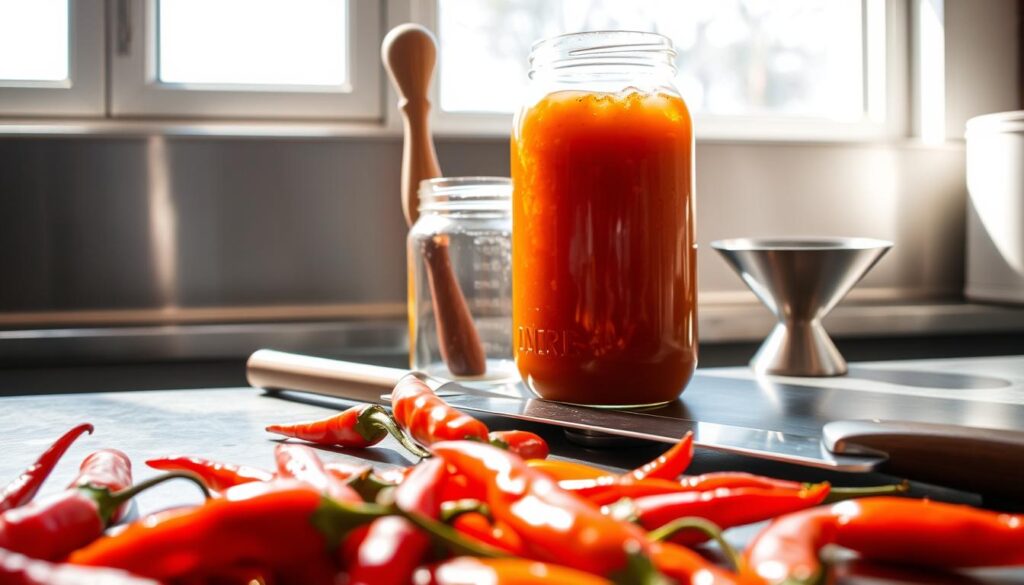
Making your own fermented hot pepper sauce is a fun journey. It mixes taste with tradition. This method turns fresh peppers into a tangy, probiotic-rich sauce that boosts your cooking.
To begin, you’ll need some key ingredients:
- Fresh peppers (jalapeno, habanero, or mixed varieties)
- Kosher salt
- Filtered water
- Garlic cloves (2-3)
- Optional spices like cumin or coriander
Preparing fermented hot pepper sauce requires careful steps and patience. Start by chopping peppers into small, even pieces. Wear gloves to protect your hands from capsaicin!
| Ingredient | Quantity | Purpose |
|---|---|---|
| Fresh peppers | 4-5 peppers | Base of sauce |
| Salt | 1 tablespoon | Fermentation preservation |
| Water | 2 cups | Brine solution |
Keep the fermentation temperature between 68-75 degrees Fahrenheit. The process usually takes 3-5 days. You’ll see bubbling and a tangy flavor.
After fermentation, blend and strain for a smooth sauce. Add white vinegar and lime juice for extra taste. Your homemade sauce will last up to a year in the fridge!
The Fermentation Process and Timeline
Making probiotic hot sauce needs patience and careful attention. It’s a journey from fresh peppers to a tangy, flavorful sauce. This process involves several stages that change simple ingredients into a complex condiment.
The fermentation time is usually 2-6 months. Each batch gets unique traits. During this time, the sauce’s flavor and nutritional value improve a lot.
Signs of Successful Fermentation
Knowing if fermentation is successful is key. Look for these signs:
- Consistent bubbling activity
- Noticeable color changes in the pepper mixture
- Development of a tangy, complex aroma
- pH level dropping below 4.6
Tracking Fermentation Stages
| Fermentation Stage | Duration | Key Characteristics |
|---|---|---|
| Initial Stage | Days 1-3 | Leuconostoc bacteria activate, CO2 production begins |
| Middle Stage | Days 4-10 | Lactobacillus plantarum dominates, acid production increases |
| Late Stage | Days 11+ | pH stabilizes, complex flavor compounds develop |
Troubleshooting Common Issues
Creating probiotic hot sauce can have its challenges. Be aware of these common issues:
- Excessive foaming: Indicates possible bacterial imbalance
- Fermentation stalling: May need temperature adjustments
- Unexpected odors: Could mean contamination
Keeping the fermentation temperature between 68-72°F (20-22°C) is important. Also, using a 2-3% salt concentration helps ensure success.
Blending and Straining Techniques
Making the perfect artisanal pepper sauce needs careful blending and straining. These steps turn your fermented peppers into a tasty condiment. After fermentation, focus on getting the right texture and flavor for your sauce.
Blending your fermented peppers involves several key steps:
- Use a high-powered blender for smooth consistency
- Add some fermentation brine to adjust thickness
- Blend in stages to control texture
For a smooth sauce, straining is key. Professional hot sauce makers recommend using a fine-mesh strainer or cheesecloth to remove seeds and pulp. This makes your sauce silky-smooth, perfect for coating foods.
Here are some tips for blending and straining:
- Start with short pulses to break down pepper chunks
- Gradually increase blending time for desired consistency
- Strain multiple times for an ultra-smooth texture
- Taste and adjust flavor with additional brine or spices
Creating an exceptional artisanal pepper sauce takes patience and trying new things. Each batch will be unique, letting you craft your own special flavor.
Storage and Preservation Methods
Making homemade organic hot pepper condiment needs careful storage and preservation. Your fermented hot sauce stays flavorful and full of probiotics if stored right.
Keeping your fermented hot sauce fresh is key. Refrigeration is vital for its long shelf life.
Bottling Techniques for Maximum Preservation
Here’s how to bottle your fermented hot sauce:
- Use clean, sterilized glass bottles with tight-fitting lids
- Leave a small air gap at the top for expansion
- Ensure complete sealing to prevent contamination
Temperature and Light Considerations
Your organic hot pepper condiment does best under certain conditions:
| Storage Factor | Recommended Condition |
|---|---|
| Temperature | Refrigerate between 38-40°F |
| Light Exposure | Store in dark glass bottles or in a dark fridge |
| Shelf Life | 3-6 months for best flavor and probiotics |
By sticking to these storage tips, you’ll keep your homemade fermented hot sauce tasty and healthy. Enjoy your organic hot pepper condiment for months.
Recipe Variations and Flavor Enhancements
Making your own spicy condiment is a fun journey. It lets you turn a simple hot sauce into something special. You can try different flavors and ingredients that match your taste.
Begin by adding these creative touches to your fermented hot pepper sauce:
- Fruit Infusions: Mango, pineapple, or passion fruit can add sweet complexity
- Herb Blends: Fresh cilantro, basil, or thyme for aromatic depth
- Spice Combinations: Cumin, coriander, or smoked paprika for unique undertones
- Roasted Vegetables: Garlic, onions, or carrots for enhanced flavor
After fermentation, you can tweak your tangy hot sauce with:
- Vinegar for increased tanginess
- Honey or maple syrup to balance heat
- Citrus juices for brightness
- Olive oil for smoother texture
The secret to a great spicy condiment is finding the right mix of heat, acidity, and sweetness. Feel free to try new things and make a sauce that shows off your cooking skills!
Conclusion
Making your own fermented chili sauce is more than a fun cooking project. It opens up a world of flavors and health benefits. By following this guide, you can turn simple peppers into a lively, healthy condiment that beats store-bought ones.
Your homemade chili sauce is a personal creation where science and creativity meet. Every batch lets you try new pepper mixes, vinegar types, and ways to ferment. You’ll learn to make sauces that show off your taste and creativity.
Fermentation is both an art and a science. Your first tries might not be perfect, but with practice, you’ll get better. You’ll learn to mix flavors, control fermentation times, and pick the best peppers. Enjoy the learning, share your sauces with friends, and keep exploring the world of fermented chili sauce.
Begin your fermentation journey today. Your taste buds and gut health will love the tasty, healthy journey ahead!
Chef Tools Recommended for Fermenting spicy Peppers:
- Digital kitchen scale
- Food processor
- sharp chef’s knife
- Wide-mouth mason jars
- Digital pH meter
- Fermentation weights
- Airlocks
Check This For More Homemade Fermenting Hot Peppers Recipes

